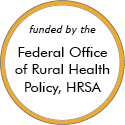Rural Tribal Health – Models and Innovations
These stories feature model programs and successful rural projects that can serve as a source of ideas and provide lessons others have learned. Some of the projects or programs may no longer be active. Read about the criteria and evidence-base for programs included.
Effective Examples
Care for Our Elders/Wakanki Ewastepikte
Updated/reviewed June 2024
- Need: To provide Lakota elders with tools and opportunities for advance care planning.
- Intervention: An outreach program in South Dakota helps Lakota elders with advance care planning and wills by providing bilingual brochures and advance directive coaches.
- Results: Care for Our Elders saw an increase in the number of Lakota elders understanding the differences between a will and a living will and the need to have end-of-life discussions with family and healthcare providers.
Other Project Examples
One Health Recovery Doulas


Updated/reviewed November 2024
- Need: To support pregnant and parenting women with a history of substance use, mental health, or co-occurring disorders in rural areas of Montana.
- Intervention: One Health, a consortium of Federally Qualified Health Centers (FQHCs), developed a team of "recovery doulas" – individuals who are dual-certified as doulas and peer-support specialists. The One Health recovery doula program offers group and individual services to women and their partners from pregnancy through the first years of parenthood.
- Results: A team of nine recovery doulas (or doulas-in-training) employed by One Health offer services in 13 rural Montana counties. Recovery doulas have provided essential support to women with substance use disorder, survivors of sexual abuse, unhoused individuals, and individuals facing other complex challenges.
St. Francis Mission Dental Clinic
Added August 2024
- Need: To improve oral health among the residents of the Rosebud Reservation in South Dakota.
- Intervention: St. Francis Mission founded a dental clinic, staffed by volunteers from across the country, to offer free oral healthcare to residents of the Rosebud Reservation.
- Results: The clinic typically offers 20 one-week clinics every year and has served 3,000 patients since transitioning to electronic records in 2021.
Wisconsin Tribal Elder Food Box Program
Updated/reviewed June 2024
- Need: To address food insecurity and limited access to healthy foods among Indigenous elders living in tribal nations in Wisconsin.
- Intervention: The Tribal Elder Food Box Program distributes biweekly boxes filled with culturally relevant, locally-sourced meat, produce, and shelf-stable foods to elders in all 11 federally recognized tribal nations in Wisconsin – 10 of which are located in rural areas.
- Results: In 2023, the program distributed 28,500 boxes and purchased a majority of food products from Indigenous producers and growers.
Nicotine Use Prevention and Control (NUPAC) Program
Updated/reviewed January 2024
- Need: To foster relationships with American Indian people in New Mexico to determine culturally appropriate practices in reducing nicotine addiction.
- Intervention: NUPAC provides outreach, community programs, and cessation services.
- Results: In fiscal year 2023, 1,333 QUIT NOW and DEJELO YA quit line enrollees stopped using tobacco.
Portable Alternative Sanitation System (PASS)
Updated/reviewed December 2023
- Need: To bring low-cost water and sanitation improvements to homes in Alaska Native villages without access to piped water or sewer systems.
- Intervention: The Portable Alternative Sanitation System (PASS) treats hauled water, provides for handwashing with clean water, and disposes waste without traditional piping.
- Results: Residents in the pilot project reported that PASS was cleaner and healthier than the self-haul method.
Facing Diabetes: Quality Improvement in Rural South Dakota Project

Updated/reviewed May 2023
- Need: To help adults and children in rural South Dakota prevent or manage their diabetes.
- Intervention: The Facing Diabetes Project offered medical visits for adults and provided prevention and education sessions for the local 4th and 5th graders.
- Results: Many adults and children in the region felt better equipped to choose healthy foods, exercise regularly, and manage their stress: all factors that can help prevent diabetes or decrease its effects.
Fostering Futures in Menominee Nation
Updated/reviewed August 2022
- Need: Since the late 1800s, trauma caused by historic events have greatly affected the way of life for Menominee Indians living on the Menominee Reservation. Economic, socioeconomic, behavioral health, and physical health issues have risen and are causing direct implications for Menominee youth.
- Intervention: Through Fostering Futures, clinic, school, and Head Start/Early Head Start staff are trained in administering trauma-informed care and building resilience among children.
- Results: Behavioral health visits at the Menominee Tribal Clinic have increased, school suspension rates have decreased, and graduation rates have improved from 60% to 94% since 2008.
Last Updated: 11/20/2024

